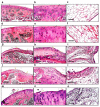Ameliorative Effect of Dabigatran on CFA-Induced Rheumatoid Arthritis via Modulating Kallikrein-Kinin System in Rats
- PMID: 36142208
- PMCID: PMC9499658
- DOI: 10.3390/ijms231810297
Ameliorative Effect of Dabigatran on CFA-Induced Rheumatoid Arthritis via Modulating Kallikrein-Kinin System in Rats
Abstract
Rheumatoid arthritis is an autoimmune disease that affects joints, leading to swelling, inflammation, and dysfunction in the joints. Recently, research efforts have been focused on finding novel curative approaches for rheumatoid arthritis, as current therapies are associated with adverse effects. Here, we examined the effectiveness of dabigatran, the antithrombotic agent, in treating complete Freund's adjuvant (CFA)-induced arthritis in rats. Subcutaneous injection of a single 0.3 mL dosage of CFA into the rat's hind leg planter surface resulted in articular surface deformities, reduced cartilage thickness, loss of intercellular matrix, and inflammatory cell infiltration. There were also increased levels of the Anti-cyclic citrullinated peptide antibody (ACPA), oxidative stress, and tissue Receptor activator of nuclear factor-kappa B ligand (RANKL). Proteins of the kallikrein-kinin system (KKS) were also elevated. The inhibitory effects of dabigatran on thrombin led to a subsequent inhibition of KKS and reduced Toll-like receptor 4 (TLR4) expression. These effects also decreased RANKL levels and showed anti-inflammatory and antioxidant effects. Therefore, dabigatran could be a novel therapeutic strategy for arthritis.
Keywords: ACPA; Bradykinin; Kallikrein-Kinin system; RANKL; dabigatran; rheumatoid arthritis.
Conflict of interest statement
The authors declare no conflict of interest.
Figures






Similar articles
-
Nicorandil and theophylline can protect experimental rats against complete Freund's adjuvant-induced rheumatoid arthritis through modulation of JAK/STAT/RANKL signaling pathway.Eur J Pharmacol. 2018 Mar 5;822:177-185. doi: 10.1016/j.ejphar.2018.01.009. Epub 2018 Jan 11. Eur J Pharmacol. 2018. PMID: 29337196
-
Andrographolide ameliorates oxidative stress, inflammation and histological outcome in complete Freund's adjuvant-induced arthritis.Chem Biol Interact. 2020 Mar 1;319:108984. doi: 10.1016/j.cbi.2020.108984. Epub 2020 Feb 13. Chem Biol Interact. 2020. PMID: 32061742
-
Venlafaxine alleviates complete Freund's adjuvant-induced arthritis in rats: Modulation of STAT-3/IL-17/RANKL axis.Life Sci. 2019 Jun 1;226:68-76. doi: 10.1016/j.lfs.2019.03.063. Epub 2019 Mar 28. Life Sci. 2019. PMID: 30928406
-
Total glucosides of paeony improve complete freund's adjuvant-induced rheumatoid arthritis in rats by inhibiting toll-like receptor 2-mediated tumor necrosis factor receptor-associated factor 6/ nuclear factor-kappa B pathway activation.J Tradit Chin Med. 2019 Aug;39(4):566-574. J Tradit Chin Med. 2019. PMID: 32186105
-
Nimbolide attenuates complete Freund's adjuvant induced arthritis through expression regulation of toll-like receptors signaling pathway.Phytother Res. 2023 Mar;37(3):903-912. doi: 10.1002/ptr.7672. Epub 2022 Nov 27. Phytother Res. 2023. PMID: 36437579
Cited by
-
The Inflammatory Link of Rheumatoid Arthritis and Thrombosis: Pathogenic Molecular Circuits and Treatment Approaches.Curr Issues Mol Biol. 2025 Apr 18;47(4):291. doi: 10.3390/cimb47040291. Curr Issues Mol Biol. 2025. PMID: 40699690 Free PMC article. Review.
-
Quantum Health Accelerator® Ameliorates CFA-Induced Animal Model of Rheumatoid Arthritis: Investigating the Role of Immunomodulatory and Anti-Oxidative Effects.Brain Sci. 2025 Feb 23;15(3):232. doi: 10.3390/brainsci15030232. Brain Sci. 2025. PMID: 40149754 Free PMC article.
-
Antioxidant Properties of Oral Antithrombotic Therapies in Atherosclerotic Disease and Atrial Fibrillation.Antioxidants (Basel). 2023 May 30;12(6):1185. doi: 10.3390/antiox12061185. Antioxidants (Basel). 2023. PMID: 37371915 Free PMC article. Review.
-
Beyond Anticoagulation: A Comprehensive Review of Non-Vitamin K Oral Anticoagulants (NOACs) in Inflammation and Protease-Activated Receptor Signaling.Int J Mol Sci. 2024 Aug 10;25(16):8727. doi: 10.3390/ijms25168727. Int J Mol Sci. 2024. PMID: 39201414 Free PMC article. Review.
-
Interleukins (Cytokines) as Biomarkers in Colorectal Cancer: Progression, Detection, and Monitoring.J Clin Med. 2023 Apr 25;12(9):3127. doi: 10.3390/jcm12093127. J Clin Med. 2023. PMID: 37176567 Free PMC article. Review.
References
-
- Youssef M.E., Abd El-Fattah E.E., Abdelhamid A.M., Eissa H., El-Ahwany E., Amin N.A., Hetta H.F., Mahmoud M.H., El-Saber Batiha G., Gobba N., et al. Interference With the AMPKα/mTOR/NLRP3 Signaling and the IL-23/IL-17 Axis Effectively Protects Against the Dextran Sulfate Sodium Intoxication in Rats: A New Paradigm in Empagliflozin and Metformin Reprofiling for the Management of Ulcerative Colitis. Front. Pharmacol. 2021;12:719984. doi: 10.3389/fphar.2021.719984. - DOI - PMC - PubMed
MeSH terms
Substances
LinkOut - more resources
Full Text Sources
Medical

